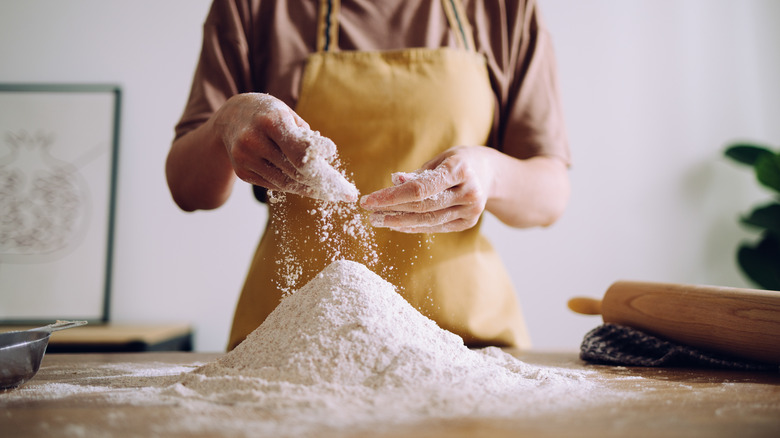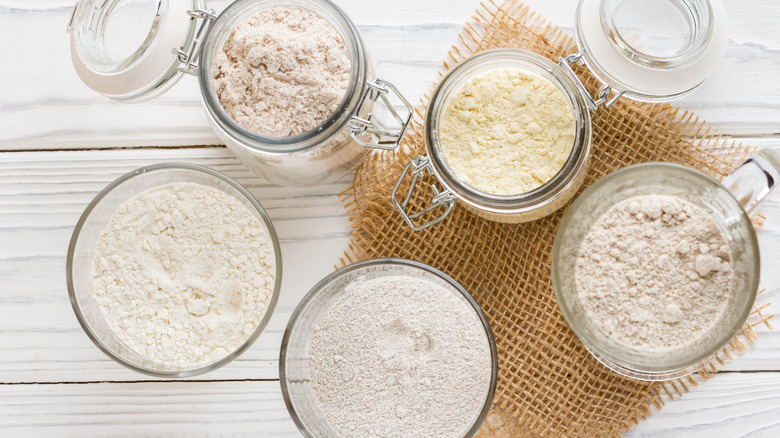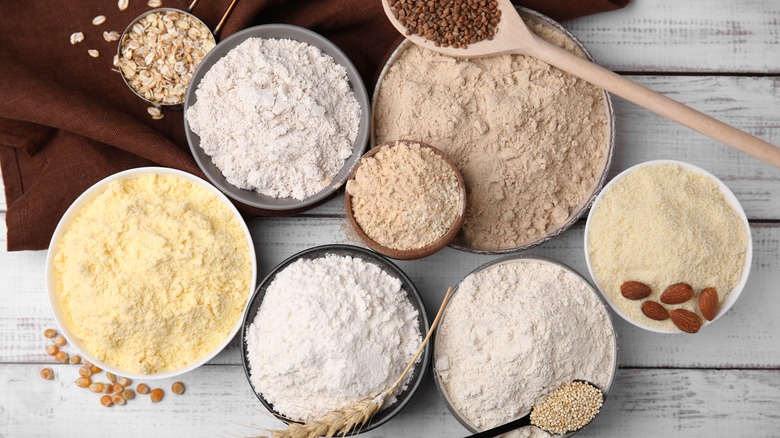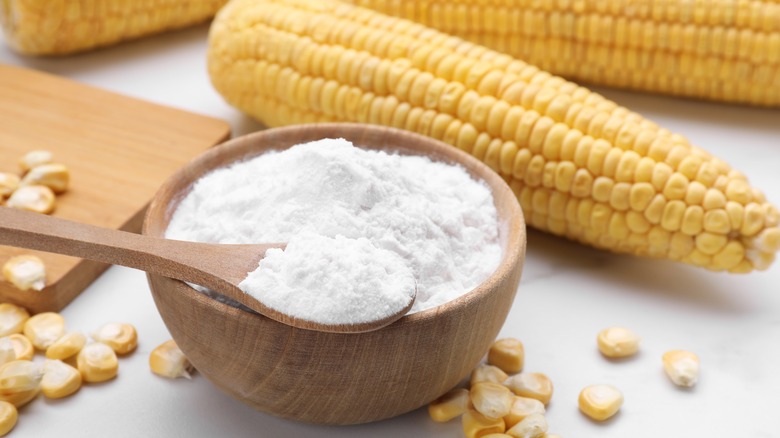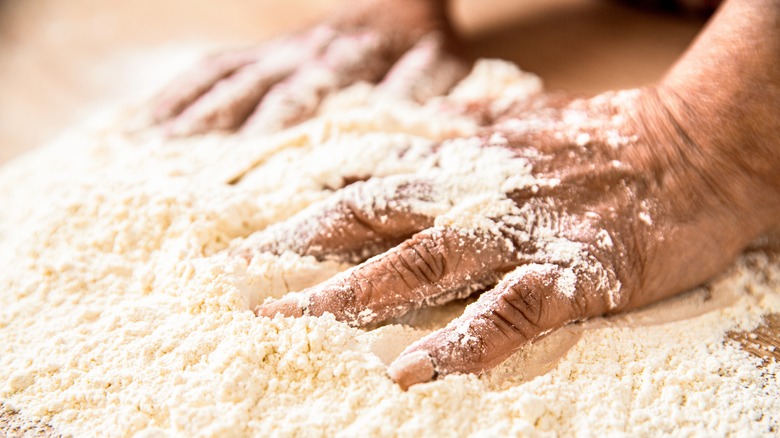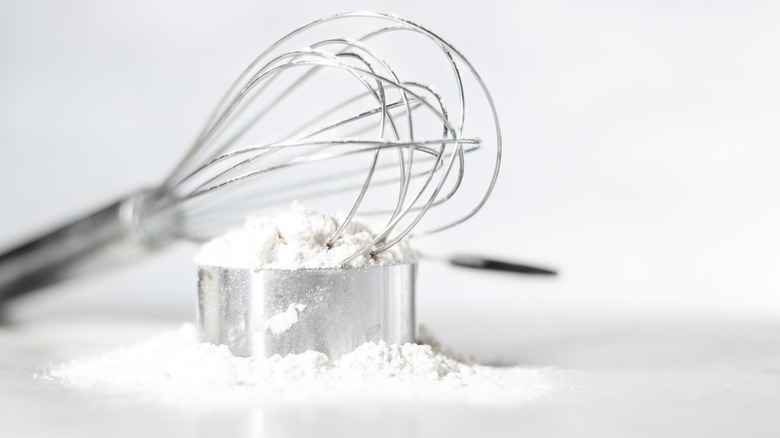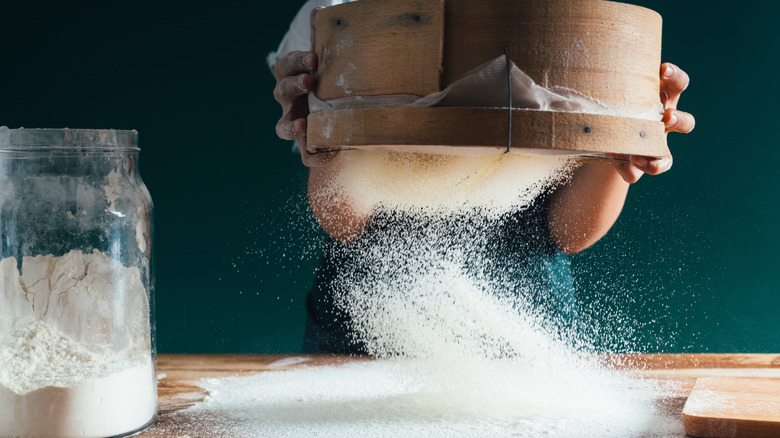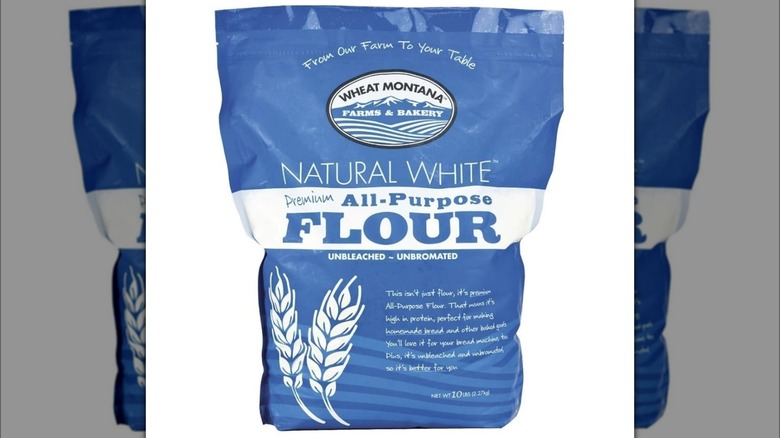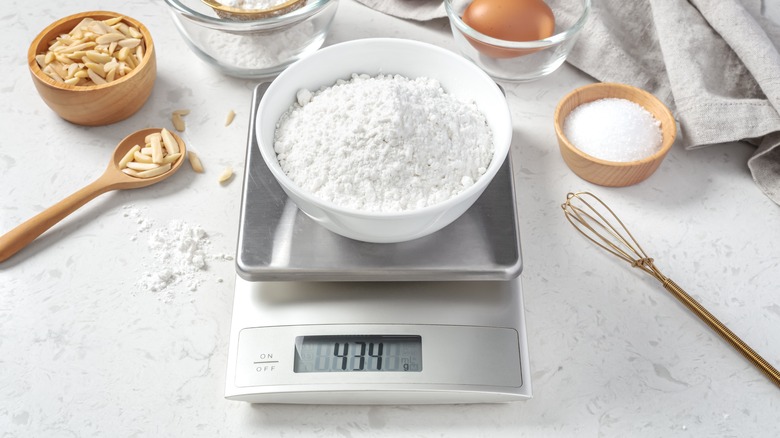False Facts About Flour You Thought Were True
We may receive a commission on purchases made from links.
From Italian pasta to Indian naan, flour is a kitchen staple all around the globe. And the U.S. is no exception. Aside from bread and other baked goods, flour is a vital ingredient in many foods we purchase at our local grocery store, including pasta and cereals. In fact, each person in the U.S. consumed more than 131.3 pounds of wheat flour in 2022, as per Statista. And while wheat flour is the most common type of flour out there, this statistic fails to take into account dozens of other flour types, such as rye flour, rice flour, almond flour, and quinoa flour.
Flour has an extremely long history. The kitchen staple was first produced around 30,000 years ago when it was ground between two stones. This ancient flour was probably quite coarse and a world apart from the refined white wheat flour we know today. Moreover, before the invention of the modern milling processes, white flour was considered a luxury item only available to the wealthy due to its cost of production. Despite its ancient roots and widespread use, it's surprising how little most of us know about flour. Don't worry — we're here to fill the gaps. Ready to find out more about the ubiquitous ingredient? Read on!
False: All flours are the same
Taking the form of a fine powder, all flour tends to have a smooth texture and a white or just off-white color. Despite these similarities, different types of flour are best suited to different culinary needs. While the most widely used flour is made from wheat, there are many other flour options, including flour made from corn, rice, oats, potatoes, coconut, or barley. What flour you use in your cooking depends on the recipe and the results you're after. For instance, corn flour has a mildly sweet flavor and tends to be denser and crumblier than other flours. Potato flour, on the other hand, has a smooth texture that works well in pancakes or as a thickener.
If you've ever baked, you're no doubt familiar with all-purpose wheat flour. Just like its name suggests, all-purpose flour is suitable for a variety of cooking and baking projects. Milled from hard and soft wheat, the pantry staple is commonly used in baked goods like cakes, cookies, pies, thickening agents, and breading for fish or meat. Self-rising flour is an all-purpose flour mixed with baking soda and a little salt. The leavening agent in self-rising flour makes it perfect for scones, muffins, and pancakes. Another popular flour type is bread flour which adds chewiness to baked goods. Made from hard wheat, bread flour is commonly used in yeast bread, rustic sourdough, and pretzels.
False: Flour has no nutritional value
If you're under the impression that flour is devoid of nutrients, you need to read this. The unassuming kitchen staple is packed with vitamins, minerals, and fiber, although the specific nutrient composition varies depending on the type of flour. From wheat to rye to almond, each flour type offers unique health benefits that are an important part of a balanced diet.
Whole wheat flour is one of the healthiest flours around. This is because it's produced from the whole grain kernels, including the germ, bran, and endosperm. Both the germ and bran contain fiber, iron, vitamin B, as well as a host of other essential minerals. On the other hand, white wheat flour is milled to remove the bran and germ. It's this process that gives refined flour its fine texture. Unfortunately, it also removes most of its nutrients. This is precisely why white wheat flour is often enriched with some of the lost vitamins and minerals.
There are many healthy alternatives to wheat flour. One popular choice is almond flour. Made from peeled and ground almonds, the flour is rich in magnesium, healthy fats, vitamin E, and plant-based protein. Coconut flour is another grain-free option that's high in nutrients like fiber, protein, iron, and potassium. Other healthy flours include quinoa flour, which contains antioxidants, fiber, iron, and unsaturated fats, and buckwheat flour, which has substantial amounts of fiber, protein, copper, iron, and magnesium.
False: You can substitute any flour for another in recipes
While substituting one flour for another in a recipe is possible, it's important to understand how each flour behaves before mixing and matching the culinary staple. This means that if you run out of all-purpose flour — or another type of flour listed in a particular recipe — all may not be lost.
The higher a flour's protein content, the denser the flour. Conversely, flours with a low protein content are usually softer and lighter. This means that a flour with a lot of protein will be a better choice for heavy artisanal breads while flour with less protein might be more suitable for cakes. For instance, whole wheat flour has a high protein content while cake flour has a low protein content. All-purpose flour has a middle-of-the-road protein content, which means that it can be used to make both bread and cakes.
As a rule of thumb, when substituting high protein flour for low protein flour, you will need to add more water to the mix to keep your dish from becoming overly dry. Conversely, when substituting low protein flour for high protein flour, hold off on the water to prevent the dough or batter from becoming overly moist, which is likely to result in a soggy final product.
False: All flour contains gluten
Since wheat contains gluten and most commercially-produced flour is made from wheat, it follows that a lot of the flour you buy at the supermarket won't be gluten-free. Also present in flour milled from rye, barley, spelt, and triticale, gluten is a protein that helps dough rise and gives baked goods their chewy texture. While this may seem far from ideal for people with celiac diseases or those sensitive to gluten, there are plenty of gluten-free flour options on the market.
Flour can be produced from a huge variety of gluten-free starches. One of the most popular gluten-free flours is made from blanched almonds. Often used in baked goods and breading, almond flour has a distinct nutty flavor. Despite its name, buckwheat flour contains no wheat or gluten. Earthy and somewhat crumbly, the flour is typically used in yeast bread. Another gluten-free flour is extracted from the arrowroot plant. While it's most often used as a thickener, arrowroot flour can also be mixed with other flour types to make baked goods. Some other gluten-free flour options include potato flour, rice flour, corn flour, nut flour, and coconut flour.
False: There is no difference between flour and cornstarch
If you thought corn flour and cornstarch were interchangeable in the kitchen, think again. The two products are quite different in their composition and uses. While both are produced from ground corn, corn flour is made from whole corn kernels while cornstarch is extracted from the endosperms of corn kernels. Aside from starch, corn flour is composed of protein, fiber, and fat. In contrast, cornstarch is made almost entirely from starch. In addition, while corn flour has a sweet and grassy taste, cornstarch is more neutral in flavor. To add to the confusion, in the U.K., cornstarch is called cornflour and corn flour is called maize.
While corn flour can be useful as a thickener, it's mostly utilized in fat-based sauces, such as roux. On the other hand, cornstarch is predominately used to add a silky texture to liquid-based dishes. Cornstarch thickeners are commonly added to sauces, soups, puddings, and gravies. For instance, cornstarch can be mixed with meat juices to make au jus gravy. The powdery ingredient can also be used to coat fried foods and give them a crunchy finish. For best results, mix the cornstarch with cold water, and slowly incorporate it into your dish.
False: Eating uncooked flour is safe
Not many people are aware that eating uncooked flour can make you sick. In fact, according to a 2019 U.S. Food and Drug Administration study, the majority of people in the U.S. believe that flour is unlikely to contain germs. In addition, the survey found that 35% of people said that they have eaten or tasted uncooked flour in the past year. As such, it's not surprising that the FDA and the Centers for Disease Control and Prevention have had to deal with numerous outbreaks of food poisoning caused by bacteria contained in raw flour. For instance, in 2023, the FDA recalled Gold Medal unbleached and bleached flour that contained salmonella.
The reality is that uncooked flour or dough can be infested with harmful bacteria such as E. coli and salmonella. This is because raw flour hasn't been treated to kill bacteria. It's the high temperatures from cooking or baking that kill germs, rendering the product safe to eat. This means that even dough that doesn't contain raw eggs can be potentially harmful. In addition, it's important not to let children play with flour dough, in case they accidentally decide to taste it or put their hands in their mouth after touching it. If you happen to knead your dough on the kitchen counter, be sure to clean the area with soap and warm water before it comes in contact with other food.
False: Bleached flour is toxic
Some people choose to stay away from bleached flour, believing it to be detrimental to health without fully understanding what it is. While bleached flour is generally inferior to its unbleached counterpart, it's not toxic, nor is eating it likely to make you sick. To cut a long story short, milled flour has to be aged for a month or two in order to turn white. To avoid this lengthy process, some manufacturers treat their flour with agents that speed up the aging process and turn the kitchen staple white shortly after milling.
Despite different processing, both bleached and unbleached flour are similar in appearance. However, they do differ in consistency, with bleached flour being more finely textured and more absorbent. These properties make bleached flour great for making cookies, pancakes, waffles, and pie crusts. Bleached flour also has a longer shelf life than unbleached flour.
While bleached flour is unlikely to result in any long-term side effects, it can be detrimental to health. This is because manufacturers use various bleaching agents to speed up the flour's whitening process. Just some of these substances include azodicarbonamide, which is believed to cause asthma, and chlorine dioxide, which has been linked to type 2 diabetes. Another issue is that while the bleaching agents may not be inherently bad in themselves, they can destroy some of the healthy nutrients present in flour.
False: You need to sift flour before using it
Most of us are probably familiar with recipes that call for the sifting of flour before use. Traditionally, this process not only helped to break up any clumps in the flour but also aerated it. This, in turn, ensured that the kitchen staple could be measured more accurately and mixed more evenly with other ingredients. However, not all of us know that today's advanced milling processes have largely eliminated the need for sifting flour.
Filtering flour used to play an important part in cooking because the product was often milled unevenly, resulting in particles of various sizes. Flour also used to contain contaminants that had to be sifted out, including seeds, husks, and bugs. Today's processing techniques have eliminated both issues, which means that the flour you purchase at the grocery store is both uniformly sized and free of debris.
Sifting flour can be beneficial in certain situations. For instance, flour that's stored in a bag for several months can settle and may need to be agitated. Sifting can also help to mix flour with other dry ingredients such as cocoa and spices. In addition, lightly dusting your work surface with flour — rather than scattering it by hand — before kneading dough can stop it from becoming overly dense and dry.
False: Flour doesn't expire
While flour is a dry, shelf-stable food that can be stored at room temperature, it does expire. Since you're unlikely to go through a bag of flour in a hurry — unless you're a baking enthusiast — it's important to know when to bid your flour goodbye. All bags of flour come with a "best by" date, which indicates when the product is at its optimal quality, not when it should be thrown away. This is why it's important to be aware of the signs of rancidity in flour. For instance, a musty or sour smelling flour normally indicates that the natural oils in the flour have oxidized. A clumpy and yellowish looking flour generally points to the presence of moisture and possible spoilage. In addition, it's crucial to throw away any bags of flour infested by weevils or other pests.
One of the factors that determines how fast a flour is likely to spoil is its ingredients. As a rule of thumb, the higher the fat content in flour, the shorter its shelf life. White all-purpose wheat flour, for example, is usually good for 12 months after the milling date because it doesn't contain any germ or bran, both of which are packed with oils. On the other end of the spectrum, nut flour is rich in oils, which shortens its shelf life to three to six months. For self-rising flour, the baking powder in the flour is likely to lose its potency over time.
False: Flour should be measured by volume and not weight
If you've ever followed a recipe only to end up with overly dry and dense baked goods, you're far from alone. While there may be many different reasons your baking endeavor could have fallen short, one common mistake is the incorrect measurement of flour. Measuring flour by volume often leads to inaccurate results. For example, a measuring cup of tightly packed flour might hold 5.5 ounces while the same cup filled with lightly fluffed-up flour could hold 4.5 ounces. The cup hasn't changed, but you end up with widely different results and a potential baking disaster on your hands.
Widely used by bakers and pastry chefs, a kitchen scale will always give you consistent and accurate results, no matter how dense or aerated the flour. However, this accuracy depends on the correct use of the kitchen appliance. Luckily, most kitchen scales are pretty straightforward to use. Simply press the "tare" button on your scale, place an empty bowl on the device, and press "tare" again. This will reset the scale to zero. You are now ready to pour flour into the bowl until you reach the desired weight.
False: Flour shouldn't be stored in the refrigerator
Being a shelf-stable product, flour can be kept in your kitchen pantry. However, since flour contains oils, storing it at room temperature is far from ideal. While this may come as a surprise to some of us, the best way to extend the shelf life of flour is to keep it in the freezer. For instance, you can keep white flour in the freezer for up to two years and whole grain flour for around a year. As an added bonus, just four days in the freezer will kill any bacteria that could be present in the product. If you run out of space in your freezer, popping your flour in the fridge is still preferable to keeping it on a kitchen shelf. Lastly, if you store flour in a refrigerator or freezer, allow it to reach room temperature before using it for baking or cooking, as chilled flour may not rise.
If you can't store flour in the refrigerator, place it in a cool, dry, and dark place. This can be your kitchen pantry, cellar, garage, or basement. Whatever storage option you choose, it's best to transfer the flour from its original bag to an airtight container. This won't just protect it from absorbing smells, but also shield it from moisture and light to prevent oxidation. Don't forget to mark the container with a "best by" date.
